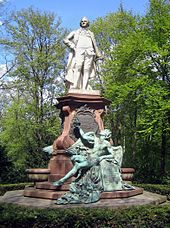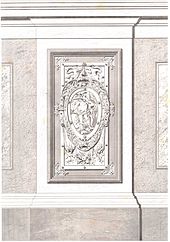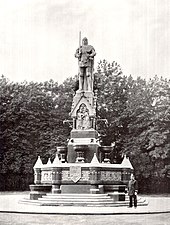Otto Lessing
Otto Lessing (* 24. February 1846 in Dusseldorf , † 22. November 1912 in Berlin ) was a German sculptor of historicism , in the second half of the 19th century shaped the appearance of the new capital. He was the son of the history painter Carl Friedrich Lessing and great-great-nephew of the poet Gotthold Ephraim Lessing .
Life
Otto Lessing's artistic training began with his father, who taught him painting. He then learned sculpture from 1863–1865 with Carl Steinhäuser at the art school in Karlsruhe and 1865–1868 with Albert Wolff in Berlin. After these years of training Lessing went back to Karlsruhe, where he worked for Steinhäuser until 1872.
The founding of the German Empire with the election of Berlin to the imperial capital attracted Lessing to Berlin in the autumn of 1872 with the hope of a favorable order situation. There he opened a studio for decorative building plastic in a studio building used by several artists at Wartenburgstrasse 14 near Hallescher Tor . The then still unknown sculptor benefited from the recommendations of his uncle Carl Robert Lessing , main owner of the Vossische Zeitung with good contacts to influential politicians and artists , when he started his own business . In 1879 he took on Eugen Boermel as a journeyman, who worked in Lessing's studio for ten years before he went into business for himself.
On September 21, 1875 Lessing married Sigrid Gude, the eldest daughter of the landscape painter Hans Fredrik Gude . The father-in-law Gude moved to Berlin in 1880 and bought a representative house in the Tiergartenviertel (Grabenstrasse 50, today Kaiserin-Augusta-Strasse). The two artists set up studios in the garden house.
Lessing's success and level of awareness rose continuously at the end of the 19th century. In 1890, for example, he was accepted into the renowned Berlin Architects' Association . He received orders for sculptures or reliefs for the facades of numerous representative buildings, such as the Reichstag building , the Berlin Palace and the Berlin Cathedral . In addition to the major public contracts, Lessing also designed many commercial buildings and villas of the new bourgeoisie from plastic. He also designed the interior of the Imperial train of Kaiser Wilhelm II.
Lessing opened up a new field of activity with monument sculpture. 1886–1890 he created a monument for his great-great-uncle Gotthold Ephraim Lessing, which was erected on Lennéstrasse in the Great Zoo . During the inauguration of the monument on October 14, 1890, Lessing was awarded the title of professor and a short time later he also took up teaching at the teaching institute of the Berlin Museum of Decorative Arts .
In 1895 Lessing moved to the newly created villa colony Grunewald (Wangenheimstrasse 10), where he had a large tower villa built by the architect Heinrich Jassoy . (A studio building in Norwegian style was built there in 1898/99 according to plans by the architectural office Vollmer & Jassoy). After a short-term collaboration with Ludwig Hoffmann , Lessing gave up building sculptures and now concentrated on monument art and applied arts .
At the height of his career, Lessing was appointed senator of the Academy of the Arts and in 1911 was awarded the order Pour le mérite for science and the arts . However, as early as 1910 he had to sell his villa and moved into an apartment at Hohenzollerndamm 112 in Schmargendorf . He died there on November 22, 1912 and was buried in the Grunewald cemetery. He created his tomb himself while he was still alive.
Lessing's last work was the monumental Luther memorial, which was unveiled a month before his death on the north side of the tower of the newly built Hamburg Michel .
plant


Painting and sculpture
| 1870 | Figure gladiator |
| 1873 | Decorative paintings in the dome of the former Völkerkundemuseum and glass mosaic in the vestibule, corner of Prinz-Albrecht-Strasse / Köngigrätzer Strasse (today Niederkirchnerstrasse / Stresemann-Strasse), Berlin (destroyed) |
| 1875-1878 | Participation in the renovation of the Reichskanzlerpalais , Wilhelmstrasse 77, Berlin (destroyed) |
| 1875-1877 | Participation in the figures of technicians and inventors on the facade of Palais Borsig with the sculptors Reinhold Begas , Erdmann Encke and Emil Hundrieser , Vossstraße 1, Berlin (destroyed) |
| 1877 | two stucco reliefs with dancing maenads , Palais Strousberg , Wilhelmstrasse 70, Berlin (destroyed) |
| 1877 | Interior stucco at Café Bauer , Unter den Linden 26 / Friedrichstrasse 85a, Berlin (destroyed) |
| 1877-1881 | City coat of arms and figurative friezes between the floors of the former Kunstgewerbemuseum (today Martin-Gropius-Bau ), Niederkirchnerstraße 7, Berlin |
| 1877-1881 | Architectural sculpture and bronze doors of the Hall of Fame during the renovation of the armory , Berlin (not preserved) |
| 1878-1880 | Building sculpture at the Reich Justice Office, Vossstrasse 4–5, Berlin (destroyed) |
| 1878-1884 | Decorative building sculpture at the Technical University of Charlottenburg (with Friedrich Wilhelm Gustav Dankberg ), Berlin |
| 1880-1881 | Attic figures , portal reliefs and reliefs to the Acts of the Apostles in the interior, Deutscher Dom , Gendarmenmarkt , Berlin |
| 1882-1884 | Building sculpture Neues Gewandhaus , Leipzig (destroyed) |
| 1884-1894 | Allegories of agriculture and cattle breeding on the southwest tower, decorative vases on the attic cornice and reliefs on both sides at the west entrance with coats of arms depicting the four German kingdoms of Bavaria , Prussia , Württemberg and Saxony , Reichstag building , Berlin |
| 1886-1890 | Marble statue of Gotthold Ephraim Lessing and base bronzes (including Genius of Humanity , Allegory of Criticism ) for the Lessing Monument , Großer Tiergarten , Berlin |
| 1886 | Group mother and child |
| 1887-1891 | Building sculpture from the former Imperial Patent Office, Luisenstrasse 32–34, Berlin |
| 1888-1889 | Equipment of the railway saloon car for Kaiser Wilhelm II. |
| 1888-1895 | Figure groups of damnation and redemption for the staircase of the Imperial Court building , Leipzig (reconstructed from plaster models) |
| 1891-1895 | Building sculpture and figures of the reformers Luther and Philipp Melanchthon in the choir (destroyed), tympanum relief of Saint George above the Kaiser portal, Kaiser Wilhelm Memorial Church , Berlin |
| 1892-1894 | Reliefs on the cultural significance of the war in the ceilings of the newly created White Hall of the Berlin City Palace , Berlin (destroyed) |
| 1893 | Marble group Bacchante with Cupid |
| 1894 | marble half-figure Helmuth Karl Bernhard von Moltke |
| 1894 | marble half-length by painter Ludwig Knaus |
| 1894-1905 | each scenic relief from the life of Jesus on the three main doors and spandrel reliefs with scenes from the Acts of the Apostles under the dome, Berlin Cathedral , Berlin |
| 1895-1896 | Bust monument of the poet Wolfgang Müller von Königswinter , Königswinter |
| 1896-1901 | Building sculpture portal Stadtbad Kreuzberg, Baerwaldstrasse 64–68, Berlin |
| 1897 | Bronze reliefs Elector Friedrich II as builder of the castle and of King Friedrich I as builder of the palace at the Eosander portal of the Berlin City Palace , Berlin (destroyed) |
| 1897-1900 | Building sculpture and two wall fountains Prometheus with the Oceanids and Perseus and Andromeda on the north side of the New Marstall , Schloßplatz 7, Berlin |
| 1899-1902 | Building sculpture at the Stadtbad Prenzlauer Berg , Oderbergerstrasse 57–59, Berlin |
| around 1900 | Building sculpture on the W. Spindler company building , Leipziger Strasse 42, Berlin (purified in the 1930s) |
| 1900 | Statue of Albrecht Achilles with the accompanying busts of Werner von der Schulenburg and Ludwig von Eyb , Monument Group 17 on Siegesallee , Berlin |
| 1900 | Equestrian monument of Kaiser Wilhelm I , Hildesheim (melted down) |
| 1901-1903 | Spindlershof , Wallstrasse 9-13, Berlin |
| 1901-1904 | Bronze reliefs with final scenes from Gotthold Ephraim Lessing's pieces Miss Sara Sampson , Emilia Galotti , Nathan the Wise and Minna von Barnhelm on the ornamental pillars of the Lessing Bridge , Berlin |
| 1902-1903 | Roland fountain on Kemperplatz , Berlin (destroyed) |
| 1902-1903 | Herkulesbrunnen on Lützowplatz , Berlin (destroyed) |
| 1903-1904 | Memorial to William Shakespeare , Park an der Ilm , Weimar |
| 1903-1910 | Building sculpture (with Albert Manthe and Max Klein ) at the former Kaiser Wilhelms Academy for military medical education (today Federal Ministry of Economics and Technology ), Invalidenstrasse 48–49, Berlin |
| 1903-1914 | Allegorical representations of the sciences, university and library cities at the Berlin State Library , Berlin (together with Robert Schirmer and Constantin Starck ) |
| 1904-1905 | Participation in the renovation of the Schauspielhaus , Gendarmenmarkt , Berlin |
| 1904 | Attica figures Nährstand and military status in the Prussian mansion , Leipziger Strasse, Berlin (figures not preserved) |
| 1907 | Portrait bust of Joseph Joachim on the occasion of his funeral |
| 1910 | Pulpit, organ prospectus, bronze relief in the choir area and stucco decorations during the reconstruction of the main church St. Michaelis , Hamburg |
| 1912 | Monument to Martin Luther (statue in front of St. Michaelis ), Hamburg |
Interior of the court train of Kaiser Wilhelm II , 1888
Fonts
- (as editor) Executed architectural ornaments of the modern age. Collection of excellent ornamental designs. Wasmuth, Berlin 1880.
- (as editor) Building ornaments of Berlin. 100 panels. Wasmuth, Berlin around 1890.
literature
- Jörg Kuhn: Otto Lessing (1846-1912). Sculptor, craftsman, painter. Life and work of a sculptor of late historicism, with special consideration of his work as a building sculptor. Dissertation, Free University of Berlin 1994.
Web links
- Literature by and about Otto Lessing in the catalog of the German National Library
- The sculptor, craftsman and painter Otto Lessing (historismus.net)
- Catalog of works and photo (historismus.net database)
- Short biography of Lessing from Edition Luisenstadt
Individual evidence
- ^ Bettina Vaupel: Very Highest Railway. From imperial train stations, princely rooms and saloon cars . In: Monumente , 23rd year 2013, No. 3, pp. 9–17 (14).
| personal data | |
|---|---|
| SURNAME | Lessing, Otto |
| BRIEF DESCRIPTION | German sculptor and painter |
| DATE OF BIRTH | February 24, 1846 |
| PLACE OF BIRTH | Dusseldorf |
| DATE OF DEATH | November 22, 1912 |
| Place of death | Berlin |









